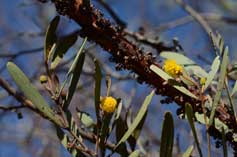In Flower This Week
A news sheet prepared by a Gardens' volunteer.
Numbers before each plant refer to temporary IFTW labels in the gardens.
Numbers in square brackets [ ] refer to garden bed Sections. Plants in flower are in bold type.
View past issues of 'In Flower This Week'.
4 February 2015
Acacia rhodophloia click for larger image |
We will visit the Red Centre Garden today. This garden has only been opened for just over a year and is still under development, being filled with plants that grow in the dry inland area of central Australia.
- On the right after you leave the Visitor Information Center is Banksia victoriae [Section 174], or Woolly Orange Banksia, with a glorious orange felty cone on long linear toothed foliage. It is native to Western Australia.
- Bear left up the hill behind the café to see on your right the huge white flowers of Crinum pedunculatum [Section 246], or Swamp Lily. These striking blooms are on thick stems and surrounded by long green strappy leaves, that often reach 2-3 metres long. The plant is found in stream and tidal areas of the Northern Territory, Queensland and New South Wales.
- As you enter the Red Centre Garden on the left is Solanum sturtianum [Section 326], or Sturt’s Nightshade, with purple flowers with yellow anthers on an open bush of grey‑green foliage. The ripe fruit of this plant is reported to be toxic to stressed sheep and cattle. It is widespread in arid regions of central Australia.
- Bear left and on your right is Acacia kempeana [Section 326], also called Wichetty Bush, a small shrub with grey-green leaves and yellow rods of flowers. It is native to Western Australia.
- On your left is Acacia rhodophloia [Section 326], a small upright tree with upward pointing linear foliage and thick yellow rods of flowers. It is native to Western Australia.
- Dipteracanthus australasicus [Section 326], on the right, is a small plant with grey-green foliage and mauve tubular bell flowers, native to Western Australia.
- Further on your right is Gossypium sturtianum [Section 326], or Sturt’s Desert Rose, the floral emblem of the Northern Territory. It is a woody shrub with grey-green water-shedding leaves and glorious purple flowers with maroon centres.
- Swainsona formosa [Section 326], or Sturt’s Desert Pea, on the left, is the iconic shiny red and black flower of central Australia. It is the floral emblem of South Australia, where it is a protected species. The flowers and plants must not be collected on private land without the written consent of the owner. Collection on Crown land is illegal without a permit.
- Calotis erinacea [Section 326] on your right is a small shrub with bright yellow daisy flowers on fresh green foliage. It is native to central Australia.
- On your right is Sida calyxhymenia [Section 326], or Tall Sida, an erect grey leaved bush with small pale yellow cup flowers. It is native to central Australia.
- On the left are several bushes of Brachyscome iberidifolia [Section 326] or Swan River Daisy with ferny foliage and bright purple, almost iridescent flowers. The plant is native to Western Australia.
- On your right is Rutidosis helichrysoides subsp. helichrysoides, or Grey Wrinklewort, with yellow pompom flowers on grey-green foliage. It is native to central Australia.
- Solanum orbiculatum subsp. orbiculatum on your left is a small, neat bush with purple “potato” flowers.
- Further on your left is Calandrinia balonensis [Section 326], or Broad-leaf Parakeelya, a low bush of bright green succulent foliage with purple flowers on wiry maroon stems. A bread-like food can be made from the seeds of this plant.
- Eremophila willsii subsp. integrifolia [Section 326], or Sandhill Native Fuchsia, in a pot is a spindly shrub with mauve tubular flowers on green foliage.
Rosalind Walcott
![Director of National Parks [logo]](../../../../images/dnp_90px.gif)







